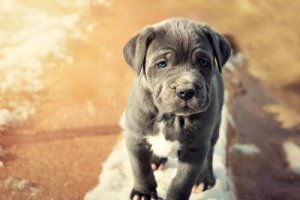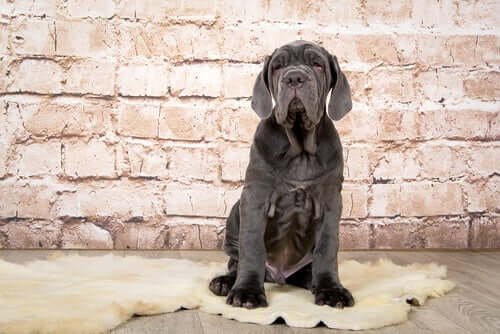The Neapolitan Mastiff: The Gentle Giant

The Neapolitan Mastiff is one of the largest dogs in the world, and descends from the older canine specimen, the Tibetan Mastiff. In this article, we’ll tell you all about the Neapolitan Mastiff, a loyal, beautiful, and mild-tempered giant.
The origins of the Neapolitan Mastiff
This breed comes from Europe and is a direct descendant of the Tibetan Mastiff, the oldest example of this canine species. Some believe that Alexander the Great brought the first Asian mastiffs from India to Greece in the year 300 B.C.
The Greeks introduced the breed to the Romans, and the Romans began to use them in the circus battles in their colosseums. The word “Mastiff” comes from the Latin word “Massivus”, which means massive, solid, and sturdy. These, of course, are the principal characteristics of this dog.
Another theory about the origins of the Neapolitan Mastiff claims that the Phoenicians brought various specimens of this dog to Britain (in the year 500 B.C.). From there, the breed continued to develop. Given its physical characteristics, it was trained to fight tigers, bears, lions and, of course, fight against the gladiators.
Whatever the case may be, Neapolitan Mastiffs are an ancient giant from the south of the Salento Peninsula of Italy. In the region of Campania, the Mastiff continued to be bred, despite war conflicts. There are several bloodlines of this breed in existence. These include Ponzano, Gheno, Vittoriale, Fossombrone, Castellaccio, Ponzo and Sole.
Characteristics and behavior of the Neapolitan Mastiff
At first glance, it’s easy to see that this breed is muscular and strong. Neapolitan Mastiffs are heavy, big, and their withers reach an average height of almost 24 inches. The weight of adult males varies between 110 and 155 pounds. They fall into the category of giant dogs, are robust and have an enormous head.

Their coats can come in different colors, including grey, gunmetal grey, brown, tawny and brindle. The Neapolitan Mastiff’s eyes are rather penetrating. Their small triangular ears hang on the sides of their heads and reach their cheeks. Their tails are thick at the top and come to a point at the end.
These dogs have a slow and unhurried gait. For that reason, they are sometimes confused with, and compared to, bears.
As for their character, Neapolitan Mastiffs are loyal, decisive, protective, vigilant, intelligent, majestic and noble. They don’t attack or bite without a very particular reason. Despite their enormous size, they’re not aggressive and perfect for homes with pets.
Mastiffs make for excellent guard dogs. If you train them from the time they are small, they are even more even-tempered, sweet and affectionate with their owners and the entire family. This includes friends and acquaintances as well. This brave animal is able to put up with physical pain, and its massive build makes it a bit of a clumsy giant.
Caring for Neapolitan Mastiffs
Caring for this canine bread is often difficult and requires a lot of work. Their temperament depends on the training they receive when they are puppies. Socializing them at an early age is fundamental in order to prevent them from becoming aggressive.
Furthermore, it’s very important for Neapolitan Mastiffs to exercise at least three times a week. This is because they are very vulnerable to becoming overweight. They can easily reach a weight of 220 pounds. Providing them with good nutrition is key to maintaining their liveliness. Veterinarians recommend offering them a diet of meat and rice every day, along with feed that’s appropriate for their breed and needs.
Don’t forget to wash their faces after meals and maintain good hygiene. This is important because the folds of their skin can accumulate dirt, grime, and moisture, which can produce infections and bad odor.
Hip displacement is a common ailment in Mastiffs, given their weight. This is yet another reason to avoid animal obesity. Other common conditions are arthritis, elbow displacement, and twisted stomach. Pay close attention to this last issue, as it can be fatal.
Before adopting a Neapolitan Mastiff, make sure you have enough space. This is a giant breed, so they cannot live in apartments or small homes. Remember that their weight and height triples between birth and the age of 3.
The Neapolitan Mastiff is one of the largest dogs in the world, and descends from the older canine specimen, the Tibetan Mastiff. In this article, we’ll tell you all about the Neapolitan Mastiff, a loyal, beautiful, and mild-tempered giant.
The origins of the Neapolitan Mastiff
This breed comes from Europe and is a direct descendant of the Tibetan Mastiff, the oldest example of this canine species. Some believe that Alexander the Great brought the first Asian mastiffs from India to Greece in the year 300 B.C.
The Greeks introduced the breed to the Romans, and the Romans began to use them in the circus battles in their colosseums. The word “Mastiff” comes from the Latin word “Massivus”, which means massive, solid, and sturdy. These, of course, are the principal characteristics of this dog.
Another theory about the origins of the Neapolitan Mastiff claims that the Phoenicians brought various specimens of this dog to Britain (in the year 500 B.C.). From there, the breed continued to develop. Given its physical characteristics, it was trained to fight tigers, bears, lions and, of course, fight against the gladiators.
Whatever the case may be, Neapolitan Mastiffs are an ancient giant from the south of the Salento Peninsula of Italy. In the region of Campania, the Mastiff continued to be bred, despite war conflicts. There are several bloodlines of this breed in existence. These include Ponzano, Gheno, Vittoriale, Fossombrone, Castellaccio, Ponzo and Sole.
Characteristics and behavior of the Neapolitan Mastiff
At first glance, it’s easy to see that this breed is muscular and strong. Neapolitan Mastiffs are heavy, big, and their withers reach an average height of almost 24 inches. The weight of adult males varies between 110 and 155 pounds. They fall into the category of giant dogs, are robust and have an enormous head.

Their coats can come in different colors, including grey, gunmetal grey, brown, tawny and brindle. The Neapolitan Mastiff’s eyes are rather penetrating. Their small triangular ears hang on the sides of their heads and reach their cheeks. Their tails are thick at the top and come to a point at the end.
These dogs have a slow and unhurried gait. For that reason, they are sometimes confused with, and compared to, bears.
As for their character, Neapolitan Mastiffs are loyal, decisive, protective, vigilant, intelligent, majestic and noble. They don’t attack or bite without a very particular reason. Despite their enormous size, they’re not aggressive and perfect for homes with pets.
Mastiffs make for excellent guard dogs. If you train them from the time they are small, they are even more even-tempered, sweet and affectionate with their owners and the entire family. This includes friends and acquaintances as well. This brave animal is able to put up with physical pain, and its massive build makes it a bit of a clumsy giant.
Caring for Neapolitan Mastiffs
Caring for this canine bread is often difficult and requires a lot of work. Their temperament depends on the training they receive when they are puppies. Socializing them at an early age is fundamental in order to prevent them from becoming aggressive.
Furthermore, it’s very important for Neapolitan Mastiffs to exercise at least three times a week. This is because they are very vulnerable to becoming overweight. They can easily reach a weight of 220 pounds. Providing them with good nutrition is key to maintaining their liveliness. Veterinarians recommend offering them a diet of meat and rice every day, along with feed that’s appropriate for their breed and needs.
Don’t forget to wash their faces after meals and maintain good hygiene. This is important because the folds of their skin can accumulate dirt, grime, and moisture, which can produce infections and bad odor.
Hip displacement is a common ailment in Mastiffs, given their weight. This is yet another reason to avoid animal obesity. Other common conditions are arthritis, elbow displacement, and twisted stomach. Pay close attention to this last issue, as it can be fatal.
Before adopting a Neapolitan Mastiff, make sure you have enough space. This is a giant breed, so they cannot live in apartments or small homes. Remember that their weight and height triples between birth and the age of 3.
This text is provided for informational purposes only and does not replace consultation with a professional. If in doubt, consult your specialist.








